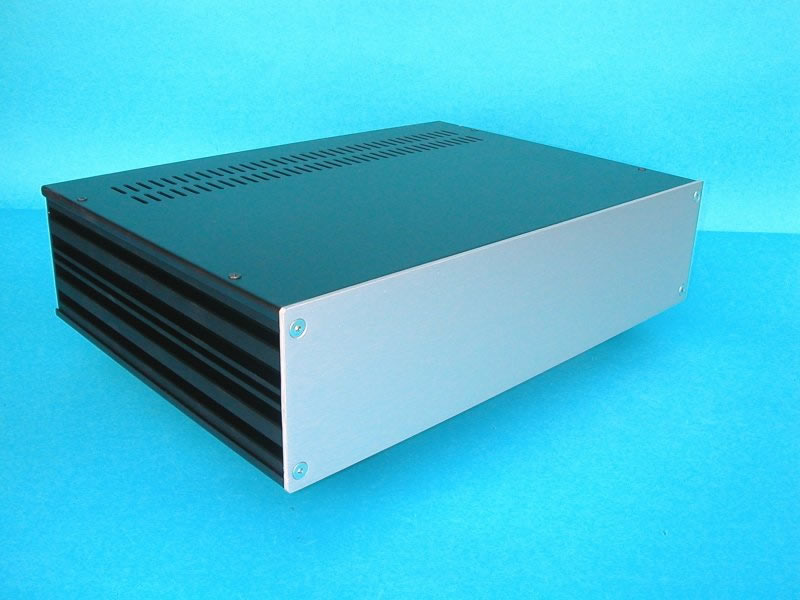 Lighter Note LDR attenuator
Lighter Note LDR attenuator
After first finding out about LDR (light dependant resistor) based attenuators a year or so ago I decided I simply must give one a try. After doing some research I stumbled across the Lighter Note which is an evolution of the Lightspeed Attenuator and addresses all of the weak points of the original's design. I should point out at this point that the Lighter Note was designed by and is sold by Uriah Dailey and the Lightspeed Attenuator was designed by George Stantscheff. In theory the Lighter Note is the ultimate passive attenuator as it only has a single component in the signal patch (one LDR per channel, it has adjustable impedance, adjustable volume range, adjustable channel balance, and a low noise power supply that incorporates a current source for the LDR's. It also incorporates a novel solution for preventing high frequency roll-off caused by the capacitance of input signal cables. All of this should mean that the Lighter Note has the minimum possible negative effect on the audio signal while allowing a great deal of flexibility in the way the circuit can be tuned to allow it to be used with a much wider range of sources and amplifiers than the standard Lightspeed Attenuator.
The standard Lightspeed attenuator requires sources with low outout impedance and amps with high input impedance. If your equipment falls outside of the recommended range then buffer stages are often required to solve impedance mismatch issues. This adds extra resistors, capacitors and transistors/valves into the signal patch which all slightly degrade the sound. The Lighter Note can be tuned to remove/reduce these impedance issues and therefore a buffer is often not required. A source with a low output impedance is still recommended though.
If you're not familiar with the Lightspeed Attenuator or the use of LDR's for volume control then I suggest you check the link above as that explains how the Lightspeed works.
So that's the theory, now for the practice...
I ordered the full Lighter Note kit from Uriah in November and it arrived shortly after. The kit includes everything you need to build a Lighter Note with the exception of a case, audio connectors, power connector and fusing and hook-up wiring. All the components, PCB and transformer are included.
I was hoping to start building the kit before Christmas but that didn't happen, so it ended up being my holiday project. The build was really quite straight forward and the PDF guide that Uriah sent me was quite detailed. The only problem I had was that in a moment of stupidity I installed the two power LED's the wrong way round. A pair of new ones from Maplin soon fixed this. 
Once the build is complete there is a simple but extremely important set of tuning steps that must be completed to ensure that the delicate LDR's are protected from being run outside of their resistance range and the impedances and volume range are setup correctly. The supplied guide explains this process very well and I had no trouble in choosing my initial impedance setup.
My existing passive attenuator is based around a 10K Alps Blue Velvet potentiometer, so I set my Lighter Note to 10K to try and keep the impedance characteristics of my system the same to start with. I'll then try experimenting with other settings later. Uriah recommends trying to get the Lighter Note's impedance as low as possible as the lower it is the more detail is let through as less resistance is in the signal path.
As cases and RCA sockets etc can be quite expensive and I wanted to use good quality ones, I decided to only order these once I had a working circuit. So I'm currently waiting for these to arrive. That means I've not yet heard my Lighter Note in my system, so I can't comment on the sound but I'll be sure to provide a comparison between my two attenuators ASAP.
I'll be using the HiFi2000 Galaxy GX283 case and WBT NextGen 0210CU-ms RCA connectors:


Initially I'm just going to mount the PCB and transformer in the bottom of the case and not attached the RCA sockets etc to the fascias. This is because Uriah is working on a new remote volume control add-on (that I want to incorporate) and I'm not sure if that will need extra or fewer holes and I don't want to drill more holes than I need and ruin the case.
Once I get home I'll take some photos of the project in its current state. I'm afraid they won't be great though as my camera is rather old. 
Source: Apple TV 4K - DAC: Beresford Bushmaster Mk II - Preamp: CI AudioPLC-1 Mk II - Power Amps: Musical Fidelity 550K mono blocks - Speakers: Wharfedale Opus 3 - Cables: Mark Grant etc - Misc: Belkin PF30 mains filters.









 Reply With Quote
Reply With Quote